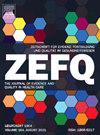Kleinräumige und soziallagendifferenzierte Betrachtungen der Inanspruchnahme von Früherkennungsuntersuchungen in der Stadt Hamburg – eine Sekundärdatenanalyse
IF 1.7
Q4 HEALTH POLICY & SERVICES
Zeitschrift fur Evidenz Fortbildung und Qualitaet im Gesundheitswesen
Pub Date : 2025-01-21
DOI:10.1016/j.zefq.2024.12.001
引用次数: 0
Abstract
Introduction
Social reporting in Hamburg identifies existing inequalities at the urban area level. These social-contextual variations may potentially influence preventive health behaviors. The aim of this article is to examine correlations between the degree of social regional disadvantage of Hamburg’s population and the utilization of regular screening examinations for children, adolescents, and adults through small-area analysis.
Methods
The analyses are based on claims data from 2017 of insured individuals living in Hamburg from three cooperating statutory health insurance funds. A socially contextual indicator (1 = “very low” to 7 = “high”) was assigned to the data at urban area level. Based on this, binary correlations between the social indicator and calculated utilization rates (stratified by gender and age) of early detection examinations were examined using Kendall’s tau correlation analysis.
Results
The study population included N = 433,053 individuals (53.7 % female) from the city of Hamburg. Strong positive associations were found between utilization rates and social contextual index classes for U7 to U9 examinations (r > 0.7; p-values < 0.05) as well as cervical cancer screening (r > 0.9; p-values = 0.002), indicating that utilization increases with the rising social status of the urban area level. Additionally, strong positive correlations can be observed in some subgroups for prostate cancer screening (> 59 years: r = 0.905, p-value = 0.004) and colorectal cancer screening (women aged 50–60 years: r = 0.905, p-value = 0.004). No significant correlations were found for other subgroups, as well as for skin cancer screening, breast cancer screening and the J1 examination (p-value > 0.05). Strong negative associations have only been detected for the general health check-up for individuals aged 35 to 59 (women: r = –0.810, p-value = 0.011; men: r = –0.714, p-value = 0.024).
Discussion and Conclusion
The results indicate inequalities in the use of early detection examinations provided by statutory health insurers for children and adults to the disadvantage of urban areas ranking lower in social status. This socially selective utilization may lead to an accumulation of health problems in urban areas that are already disadvantaged socially, which would result in an exacerbation of existing social and health inequalities. Small-scale and socially differentiated analyses of healthcare provision should be seen as a regular component of regional healthcare provision. They provide starting points for a more needs-oriented further development of the healthcare system and secondary prevention services.
[汉堡市筛查检查利用的小区域和社会差异分析:二次数据分析]。
引言:汉堡的社会报告确定了城市地区层面存在的不平等。这些社会背景差异可能潜在地影响预防性健康行为。本文的目的是通过小区域分析来检验汉堡人口的社会区域劣势程度与儿童、青少年和成人定期筛查检查的利用之间的相关性。方法:基于汉堡三个合作法定健康保险基金2017年参保人员的理赔数据进行分析。一个社会背景指标(1 =“非常低”至7 =“高”)被分配给城市地区一级的数据。在此基础上,使用Kendall's tau相关分析检验社会指标与计算的早期检测检查利用率(按性别和年龄分层)之间的二元相关性。结果:研究人群包括来自汉堡市的N = 433,053人(53.7%为女性)。在U7至U9考试中,使用率与社会情境指数等级之间存在显著的正相关(r < 0 0.7;p值< 0.05),以及宫颈癌筛查(r > 0.9;p值= 0.002),表明城市区域水平的社会地位越高,利用率越高。此外,前列腺癌筛查(50- 59岁:r = 0.905, p值= 0.004)和结直肠癌筛查(50-60岁女性:r = 0.905, p值= 0.004)在某些亚组中可以观察到强正相关。其他亚组以及皮肤癌筛查、乳腺癌筛查和J1检查之间均无显著相关性(p值bb0 0.05)。只有在35岁至59岁的个人进行一般健康检查时发现了强烈的负相关(女性:r = -0.810, p值= 0.011;男性:r = -0.714, p值= 0.024)。讨论和结论:结果表明,法定健康保险公司为儿童和成人提供的早期检测检查的使用不平等,不利于社会地位较低的城市地区。这种社会选择性利用可能导致已经处于社会不利地位的城市地区保健问题的积累,从而加剧现有的社会和保健不平等现象。对医疗保健提供的小规模和社会差异化分析应被视为区域医疗保健提供的常规组成部分。它们为进一步发展以需求为导向的医疗保健系统和二级预防服务提供了起点。
本文章由计算机程序翻译,如有差异,请以英文原文为准。
求助全文
约1分钟内获得全文
求助全文
来源期刊

Zeitschrift fur Evidenz Fortbildung und Qualitaet im Gesundheitswesen
HEALTH POLICY & SERVICES-
CiteScore
1.90
自引率
18.20%
发文量
129
 求助内容:
求助内容: 应助结果提醒方式:
应助结果提醒方式:


